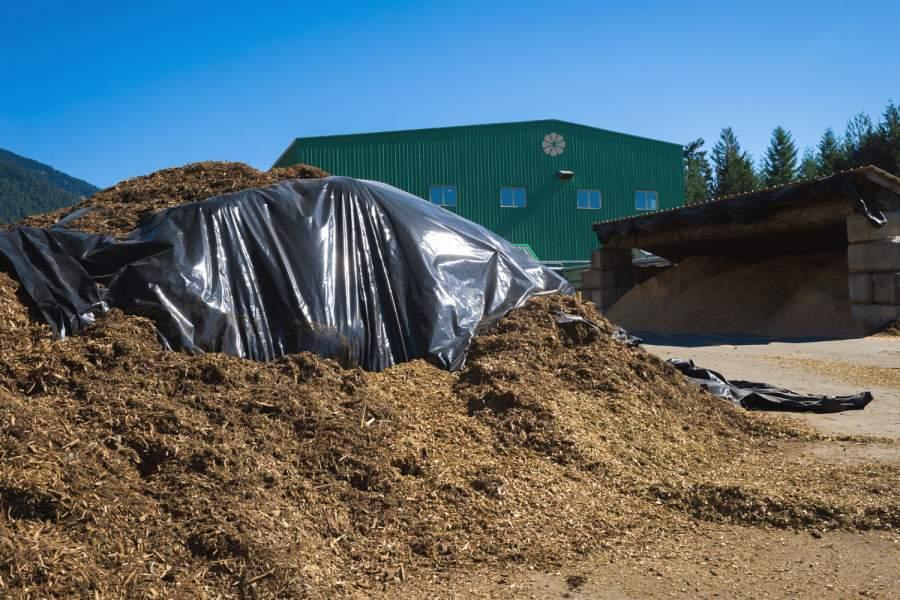If you’re serious about composting, it won’t be long before you notice your pile heating up.
Amazing! This is a vital sign that you’re doing something right and that your pile is rife with microbial activity.
But this begs the question: can compost get too hot?
In this article, I examine the situations in which a compost pile may get too hot – and in very extreme cases potentially catch fire.
But let me caveat this article now: the likelihood is that your backyard compost pile will never reach the temperatures needed to become too hot. In fact, most backyard compost piles will never even get hot enough. The size of your compost pile is directly related to how hot it can become.
With that disclaimer out of the way, let’s jump right it.
How does compost heat up?

Compost heats up due to exothermic chemical reactions going on inside the compost. These reactions release heat as a by-product. It’s a natural part of composting and something you want to happen.
If your pile isn’t heating up, it means you have very little microbial activity going on.
The exact temperature of your compost will vary depending on the following:
- The size of your compost pile
- If you’ve insulated the pile
- How well ventilated the pile is
- What stage your compost is at
- The moisture content of the pile
- The types of materials you’re composting
- The climate
- The type of bin you’re using (if you’re using one)
During the peak of composting activity, compost can get very hot.
Is my compost too hot?
Although rare amongst your average backyard composter, yes compost can get too hot.
If you’re purposefully hot composting, it’s more likely. But if you’re just chucking stuff in and hoping for the best, it’s very unlikely.
Compost is most likely to get too hot when it’s nitrogen-heavy, well insulated, and had has minimal turning.
But when is compost too hot?
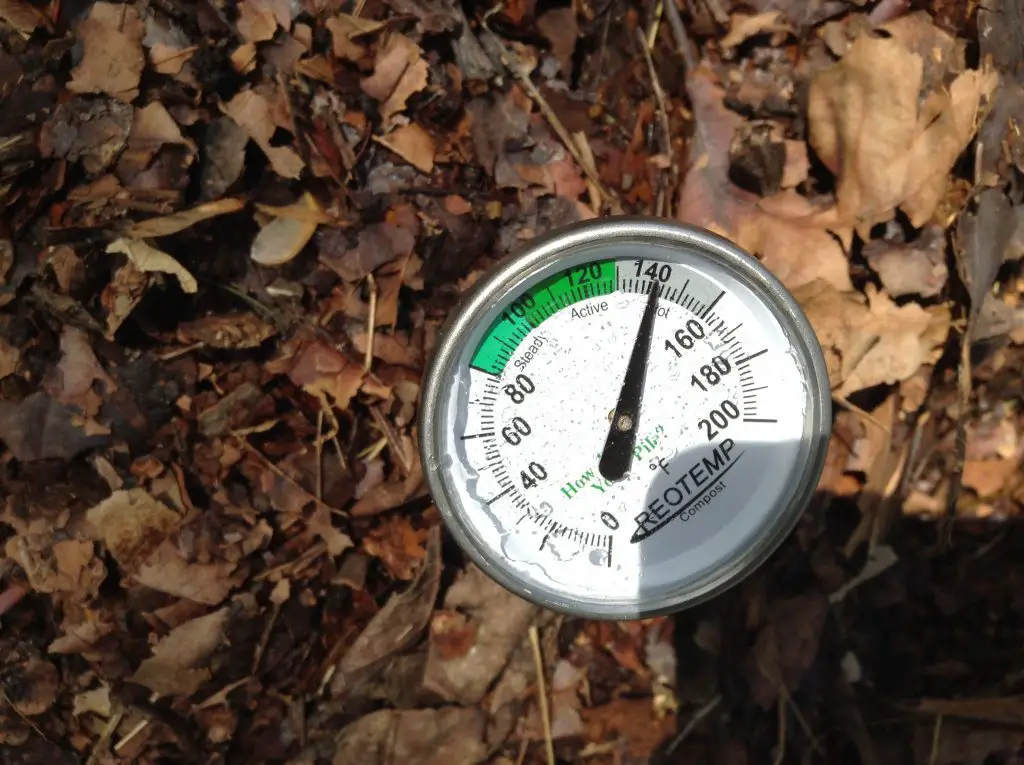
135°F – 160°F (57°C – 71°C) is the optimal temperature range for composting. At this temperature, you’ll have plenty of microbial activity and rapid decomposition. Above 160°F (71°C) is too hot. Above this temperature, the composting microbes will start to die off and decomposition will grind to a halt.
If your pile is above 160°F (71°C) for too long (half a day or so), it can become inert. If your compost climbs above 170°F (77°C) for even a few hours, the majority of microbial activity will stop.
If you see the temperature of your pile is in the mid to high 150°F’s and climbing, it’s time to take action. I go through what to do if your compost is too hot later on.
It’s important to mention here that your compost getting too hot does not mean it’s going to catch fire – this is VERY unlikely (I explain more about this later on too, you’ve got lots to look forward to!).
In reality, most composters will struggle to get their pile to 160°F (71°C), and will never have to worry about it getting too hot.
My compost is steaming does this mean it’s too hot?
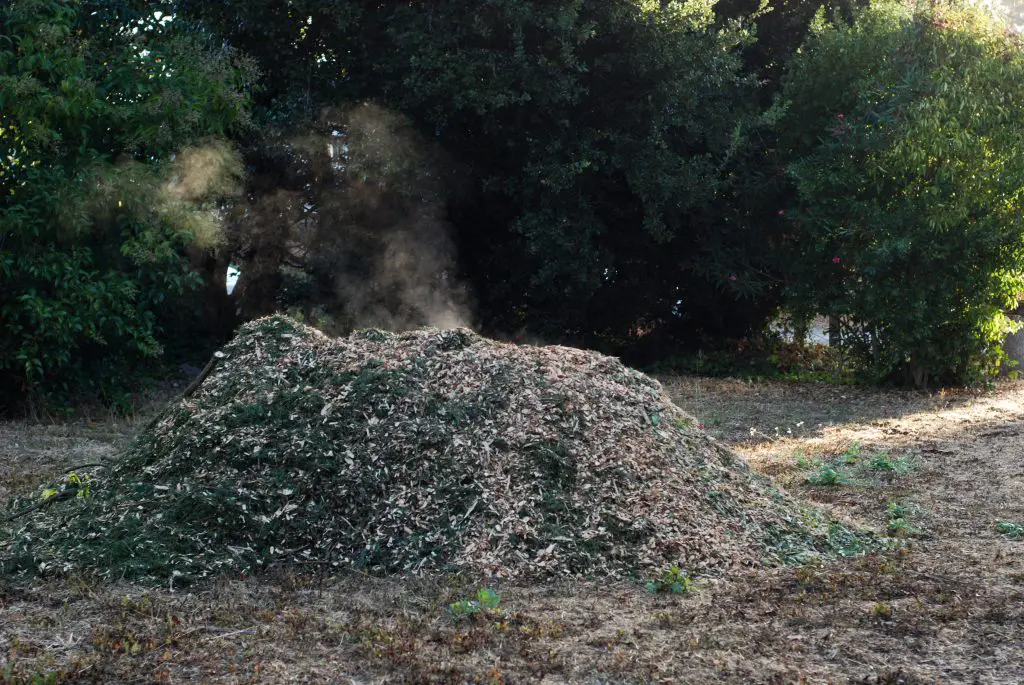
During colder days, steam is common in hot compost piles. It’s not smoke. The heat generated during the composting process causes water to evaporate and this generates steam.
Steaming compost is a good sign, it means you’ve got lots of active decomposition going on.
If you notice a lot of steam check your pile to make sure it’s not got too dry. You might need to add some more water to replace the water that’s evaporating.
How do I measure the temperature of my compost?
You can measure the temperature of your compost with a compost thermometer. Compost thermometers have long stems (around 15-20 inches is normal) so they can reach the middle of your pile and test the internal temperature.
It’s important to test a few different areas of the compost because piles don’t always heat up evenly. There may be small pockets of heat buried within a mainly cool pile.
It’s also a good idea to test different depths within the compost. This will give you a good idea of how big the active core of your compost is.

To measure my compost temperature I use this thermometer from retrograde. The stem is 20 inches long, and it has a hermetically sealed dial that won’t fog up or get damaged by water. This means you can leave the thermometer in the compost overnight to get a really accurate reading.
You can also dig a hole in the compost and touch it with your hand. This won’t give you an accurate reading but will give you an idea if the compost is heating up or not.
If the compost is uncomfortable to touch, it’s hot enough.
As you dig into the middle of the compost you may see steam coming out. This is another indication that the pile is heating up nicely. Don’t worry – it’s not smoke!
What to do if my compost is too hot?
If you notice your compost is close to reaching 160°F (71°C) the first thing to do is turn the compost. This will release some of the heat. For a longer-term solution, incorporate more carbon into the pile. Wood chips are good to add because they help improve airflow.
Turning the pile will only provide a temporary respite. When you turn the pile you introduce a new supply of oxygen, which means the compost will quickly start heating up again.
Too much nitrogen is a common problem in piles that are continually getting too hot.
To combat this, you need to increase the amount of carbon in your pile. There are plenty of things you can add to do this but something bulky like wood chips will be most effective.
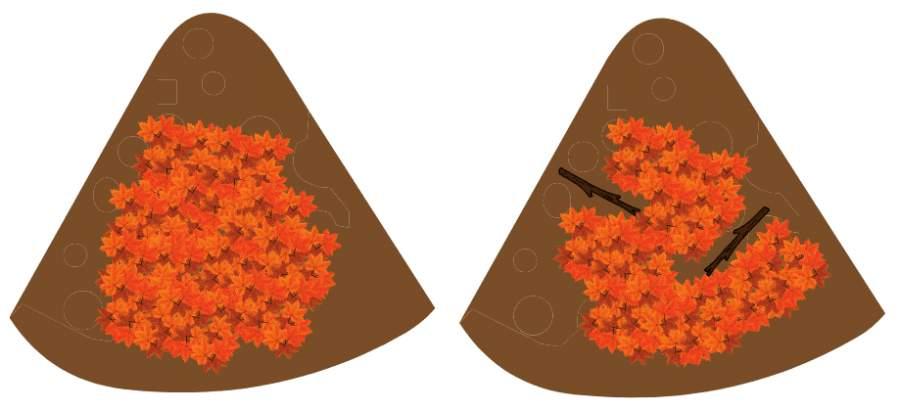
Wood chips will fluff the compost up and give the heat more escape routes. If everything you add is finely shredded and super packed together, this can impede airflow and prevent heat from escaping.
As you’re turning the pile, add some water.
Water will help cool your compost down, but the main reason for adding it that a too hot pile is in danger of becoming dry as the water evaporates.
In big compost facilities, fans are often used to cool the piles down. The fans blow cool air into the compost piles and keep the hot air moving upwards so it escapes the pile before it has a chance to overheat.
To prevent your pile from overheating again:
- Keep a good balance of green and brown materials
- Turn and water your pile frequently
- Ensure proper airflow within your pile
Can compost catch on fire?
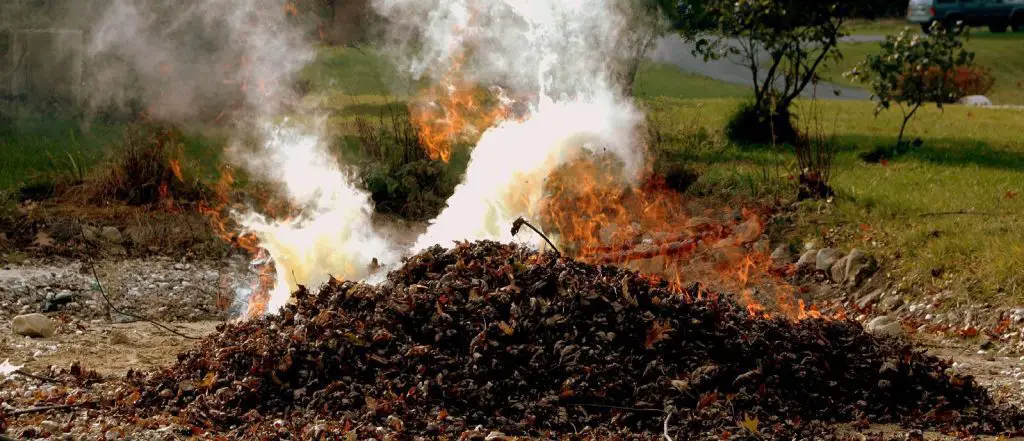
Compost piles can catch on fire, but it’s extremely rare. Small, backyard compost piles will never catch on fire. Only very large industrial-sized piles are at risk, and even then the risk is very small. Risk factors include unattended, self-insulating piles with improper moisture distribution.
You’ll have all heard the stories of someone’s compost heap spontaneously combusting. Truth is, this is extremely rare and is only possible when a specific set of criteria is met – criteria that’s almost impossible for a backyard composter to achieve.
For a compost pile to get hot enough to spontaneously combust it needs to meet the following conditions:
- There is biological activity happening within the pile
- The pile is very large – at least 6×6 feet but more likely larger
- The pile is very well insulated – the pile can either be self insulated or insulated with man-made materials
- The pile is located in a hot and dry climate – this encourages evaporation of moisture from the pile
- The pile suffers from improper moisture distribution – moist parts of the pile can heat up and the dry pockets of material are at risk of catching fire
- The pile has a non-uniform mixture of materials and sizes
- The pile has been left unattended long enough for excessive heat to build up in the pile
If you have a small pile that you attend to regularly and keep it moist and aerated throughout, then it won’t catch on fire. Only commercial piles are really at risk.
Smaller piles simply can’t get hot enough to combust. There isn’t enough insulation.
You need temperatures in excess of 300°F (149°C) for a pile to combust. Backyard composters often struggle to reach 150 °F (66°C).
Most compost piles that catch on fire will do so because of human error (e.g. someone throwing a still-lit cigarette butt on the pile).
How do compost piles catch on fire?
An example of something that would meet the conditions I outlined above would be damp hay bales or (very) large piles made entirely from wood chips.
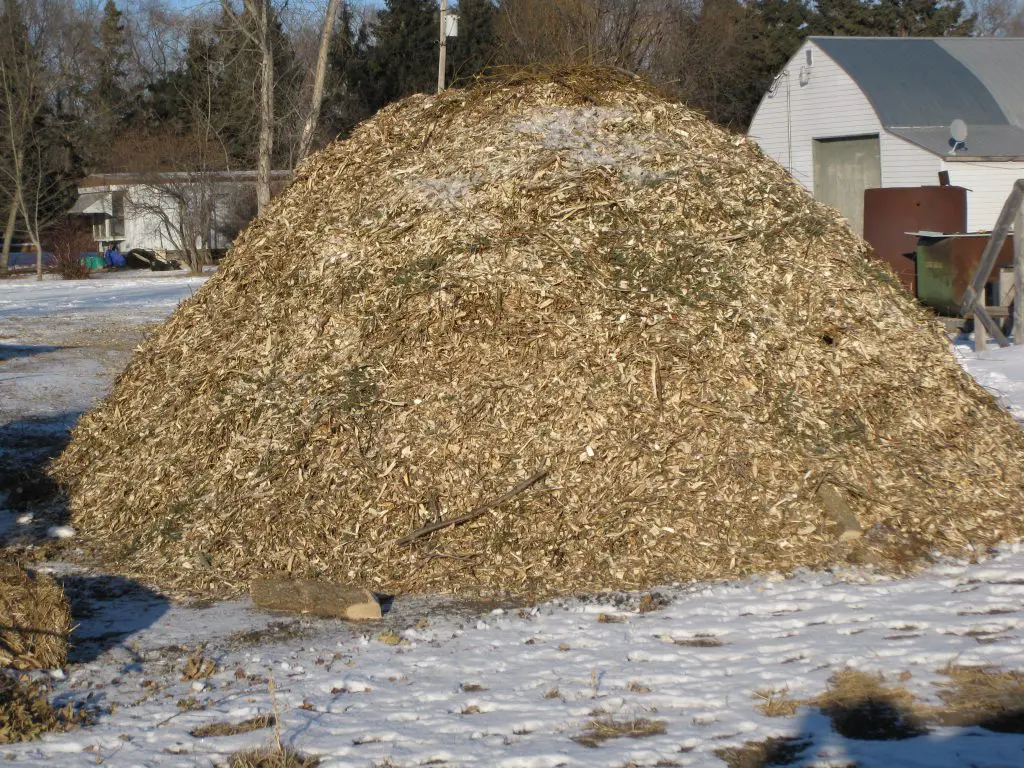
These can heat up a lot. And because they’re made from self-insulating materials, the heat can’t escape.
Let’s take an unattended (unturned) wood chips pile as an example.
- With a little bit of moisture, the middle of a big pile of wood chips will start to decompose.
- The decomposition reaction will release heat.
- Wood chips are good insulators. If the pile is large enough it will self-insulate and stop any heat from escaping.
- The introduction of heat speeds up the decomposition reaction and therefore more heat is generated – it’s a vicious circle.
- The heat will dry the surrounding wood chips out leaving them vulnerable to self-combustion.
- Eventually, the wood chips heat up so much that they spontaneously combust and the pile catches on fire.
There are several things at play in this example. Things that wouldn’t occur in a normal backyard compost pile.
If a large organic pile does happen to catch fire, it’s most likely to burn through smoldering due to the limited oxygen available. If oxygen is suddenly introduced via turning the pile then a flaming fire can erupt very suddenly.
Is there ash in my compost?
It’s very rare for compost to get hot enough to burn and produce ash. Chances are you don’t have ash in your compost but some form of fungus that looks like ash. Actinomycetes are a common occurrence in compost and the white fungus they produce can be mistaken for ash.
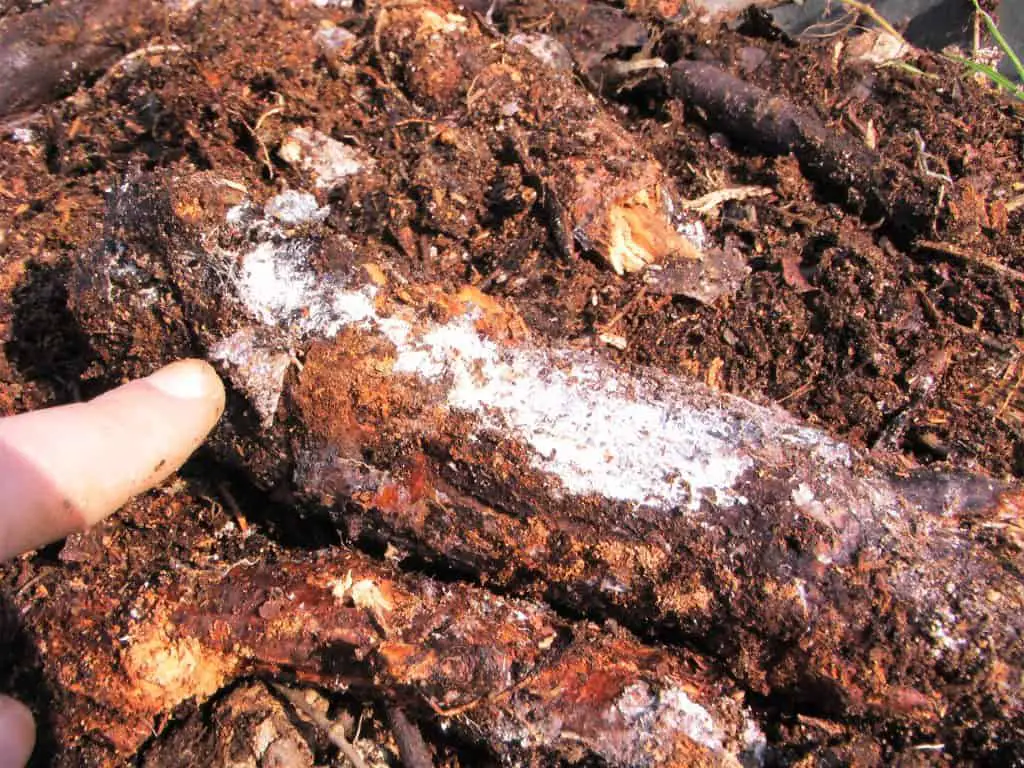
Actinomycetes thrive in hot compost, so it’s likely you’ll see them at just the same time as you suspect the pile could be hot enough to catch on fire.
If you see actinomycetes in your compost it’s a good thing.
It means your compost is decomposing well. They play a critical role in decomposing the more complex materials in your pile such as lignin which is present in wood and newspaper.
Actinomycetes are commonly reported in piles that have a lot of grass clippings as well as tougher fibrous materials.
With the right amount of moisture this mixture of materials can heat up very quickly and the actinomycetes arrive to help deal with the tougher materials.
While you should be happy to see the ash-like substance, you should be careful that not to breathe in any dust because some people can be very allergic to actinomycetes.
The allergy is commonly known as farmer’s lung and can be deadly. If you want to turn a pile covered in actinomycetes, wear a mask to be safe.
Can compost get too hot for worms?
For most, well all, of this article I’ve been talking about traditional composting. But there’s also vermicomposting, otherwise known as composting with worms.
Vermicomposters need to follow a whole new set of guidelines. Red wigglers are the most common composting worms.
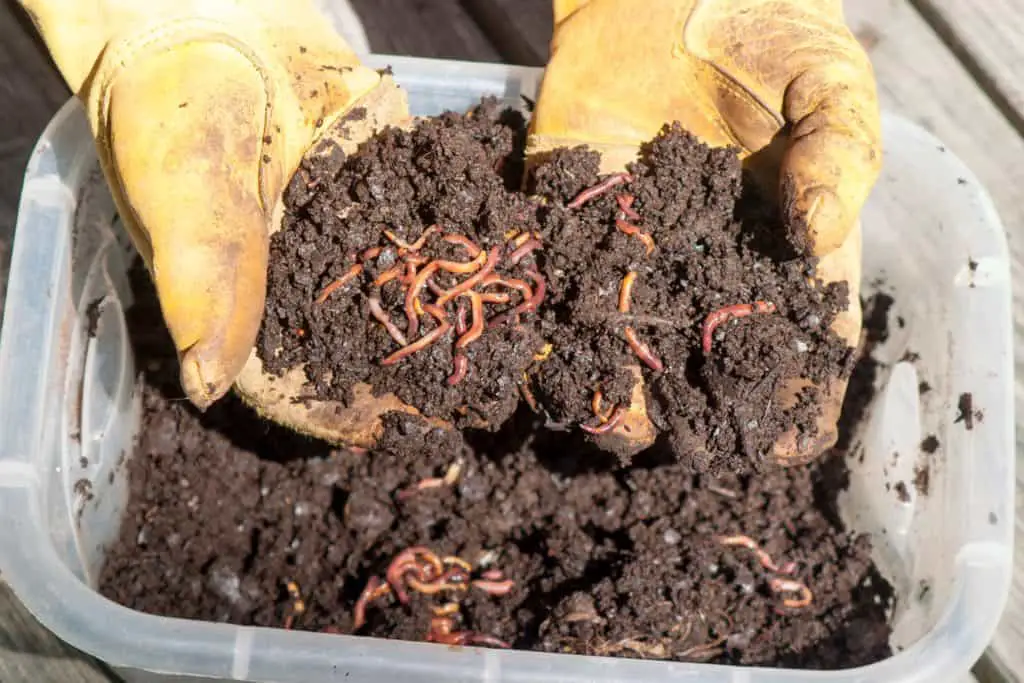
Red wigglers work best at temperatures between 55°F – 80°F (13°C – 27°C). Above 80°F (27°C) the worms will get sluggish. Temperatures above 95°F (35°C) will kill red wiggler worms.
If your worm bin gets too hot, throw some ice on top. This will cool it down and water the bedding.
You should also stop feeding your worms until the temperature is back to normal. When the worms are too hot, they become lazy and likely won’t eat the food.
This means the food will just sit there and rot, which will drive the temperature up even more. You’ll essentially turn your bin into a mini hot composter! Not what you want.
The two most common causes of a worm bin getting too hot are leaving the bin in the sun and/or overfeeding the worms.
You can prevent these from happening by positioning you bin in a cool place, and not adding food to the bin prematurely. Wait until most of the previous batch of food is gone.
If you live in a really hot climate, it’s advisable to keep your bin indoors where it’s cooler. You’ll have a hard time keeping a worm bin cool enough when the climate is working against you.
Other ideas to keep your wom bin cool include:
- Water the pile daily to keep it moist.
- Point a fan at the bin to increase airflow.
- Drill more holes into the bin to increase airflow.
- Put bottles filled with ice in the bin on really hot days.
- Drape a wet towel over the top of the bin (with the lid off).
If none of these ideas work, consider using a different type of worm. Red wigglers are most common, but there are several other species that are good for worm bins.
Blue worms are from the tropics and prefer warmer temperatures. They do best in temperatures between 70°F – 80°F (21°C – 27°C).
African nightcrawlers are another tropical worm. They prefer temperatures between 70°F – 85°F (21°C – 29°C).
Can compost get too much sun?
Too much sun can dry a compost pile out, which will bring decomposition to a halt. Composting microbes need water to survive. If you live somewhere very sunny it’s best to keep your compost pile in the shade, or you’ll be watering it constantly.
After a particularly hot spell, it’s always a good idea to check the moisture levels in your bin and water it if it seems dry. Remember, compost should have the consistency of a wet sponge.
Spending time in the sun will help heat a compost pile up, but the main heat source comes from within the compost pile. It’s not possible for a pile to overheat just from too much sun.
